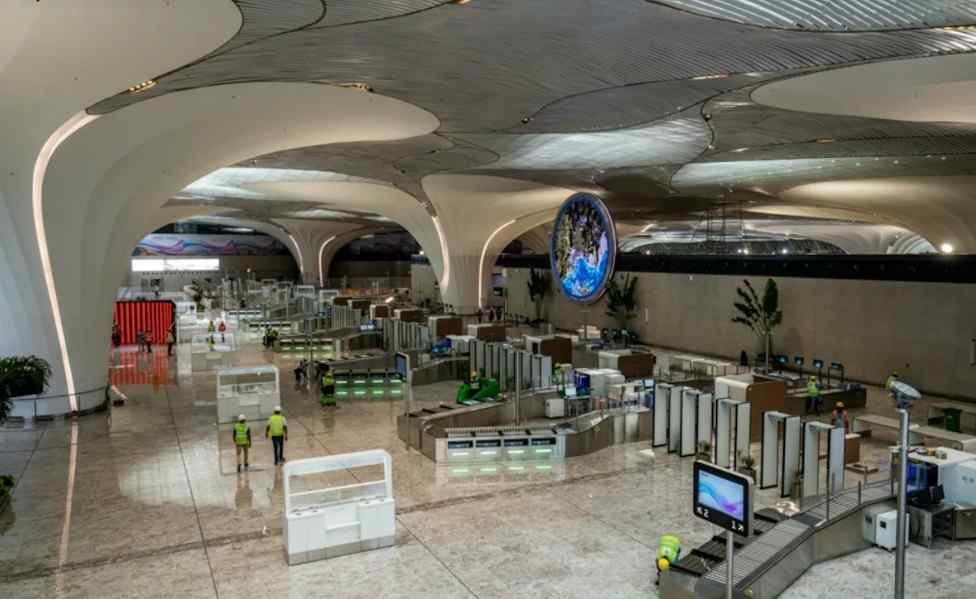A New Gateway to Western India
The long-awaited Navi Mumbai International Airport (NMIA) is set to be inaugurated by Prime Minister Narendra Modi on October 8, marking a significant milestone in India’s aviation infrastructure. Positioned approximately 37 km from South Mumbai in Ulwe, this airport will become the second in the Mumbai Metropolitan Region, easing pressure on the busy Chhatrapati Shivaji Maharaj International Airport (CSMIA).
After receiving its aerodrome licence from the Directorate General of Civil Aviation (DGCA) on September 30, the airport is fully prepared for operations. Developed by Navi Mumbai International Airport Limited (NMIAL)—a joint venture where the Adani Group holds 74% and CIDCO owns 26%—the project is designed to emerge as a global aviation hub and a symbol of modern India’s infrastructure excellence.
Expansive Design and Strategic Planning
Spread across 1,160 hectares (2,866 acres), the NMIA project is being developed in multiple phases. The final phase envisions four passenger terminals, supported by two parallel Code F-compliant runways, each measuring 3,700 meters in length and 60 meters in width.
The initial phase will feature a single integrated terminal handling both domestic and international flights, with a projected capacity to serve 20 million passengers annually. Upon completion of all phases, the airport will have the capacity to handle up to 90 million passengers per annum (MPPA) and manage 3.2 million metric tonnes of cargo annually.
The airport has been assigned the IATA code NMI and ICAO code VANM.
Architectural Brilliance Inspired by Nature
NMIA’s architectural design draws inspiration from the lotus flower, a national symbol of purity and strength. The terminal will feature 12 sculptural feature columns that rise like unfurling petals, while 17 mega columns hidden within the structure will support the iconic lotus roof canopy.
This design not only pays homage to Indian heritage but also promotes energy efficiency through passive cooling systems embedded within the netted structures of the lotus pillars. The airport aims to offer passengers a serene yet modern travel experience that merges technology with aesthetics.
Technology-Driven Smart Airport
Positioned as one of the most advanced airports in India, NMIA will feature 5G connectivity and a fully digital ecosystem. The “Connected NMIA” concept integrates Internet of Things (IoT) technology to enable real-time monitoring, automated baggage handling, and smart traffic management.
With Digi Yatra integration, passengers can expect seamless, contact-free processing, eliminating manual ID and boarding pass checks. Additionally, aviio, an in-house app, will assist airport stakeholders with operations and efficiency insights. Other advanced features include Wi-Fi connectivity with cybersecurity protection, data-driven turnaround management, and baggage tracking systems compliant with IATA 753 standards.
Exceptional Passenger Amenities
NMIA’s terminal will offer a blend of comfort, culture, and convenience. Facilities include a dedicated kids’ play zone, an 80-room transit and day hotel, and CIP lounges designed to host about 500 passengers.
An experimental digital zone will feature interactive tunnels, kinetic installations, and immersive storytelling, highlighting the heritage of Mumbai, Maharashtra, and India. The airport will also provide premium Pranaam services for meet-and-greet assistance and comprehensive baggage solutions, including home-to-destination luggage delivery, baggage wrapping, and repair services.
For visitors, a special arrival forecourt has been developed to enhance accessibility and comfort, ensuring the airport serves both passengers and accompanying guests seamlessly.
Sustainability at Its Core
Sustainability is one of NMIA’s central pillars. The airport aims to generate 47 MW of solar power in its final phase and has incorporated low-flow water fixtures, rainwater harvesting systems, and wastewater recycling technologies to minimize environmental impact.
Electric vehicles will be deployed across the airside to reduce carbon emissions, while future phases will include Automated People Movers (APMs) for internal transit. Additionally, the airport’s rockfill method used in constructing the tarmac and runways ensures long-term environmental resilience and structural stability.
A Symbol of Modern India
The Navi Mumbai International Airport stands as a testament to India’s vision for world-class, sustainable, and technologically empowered infrastructure. Once operational, NMIA is expected to transform air connectivity in Western India, foster regional economic growth, and position Mumbai among the top global aviation hubs.
As the countdown to its inauguration begins, NMIA represents not just an airport, but a landmark of innovation, culture, and progress—a gateway to a new era in Indian aviation.








